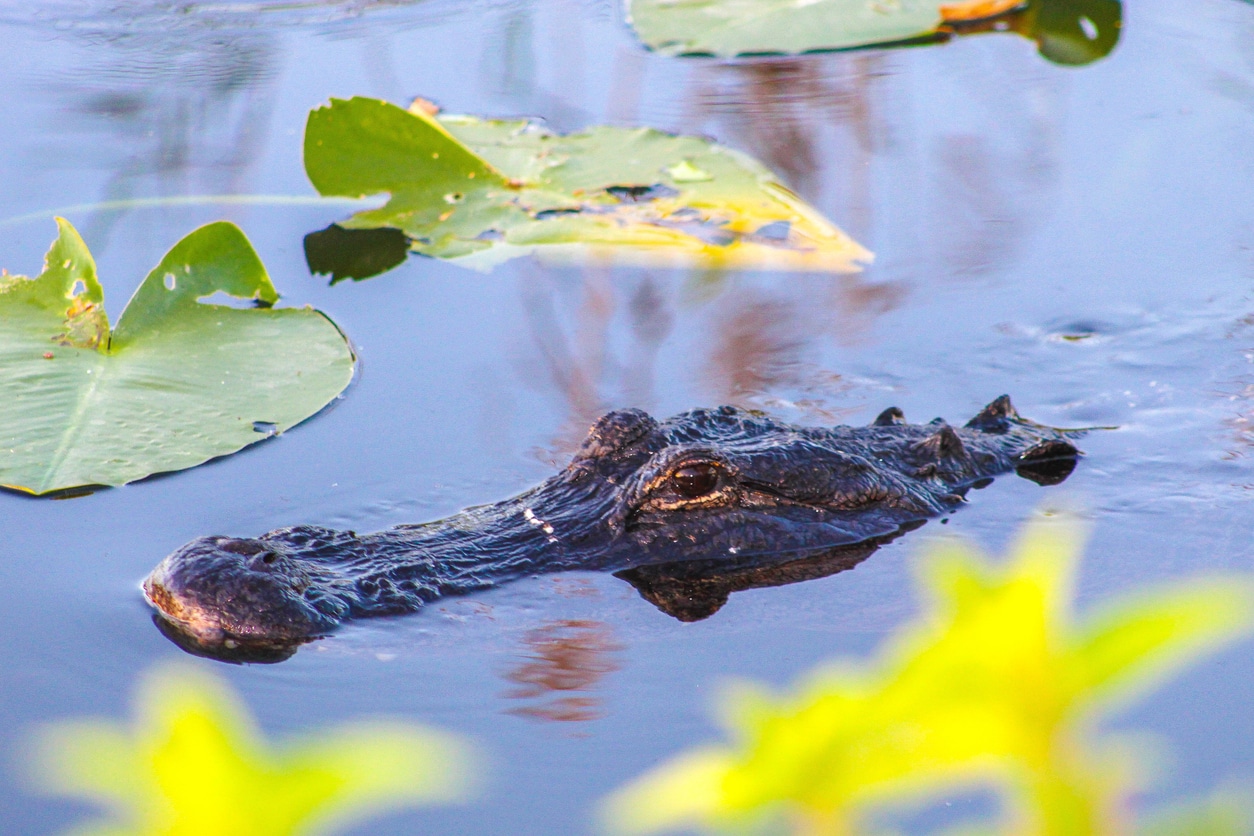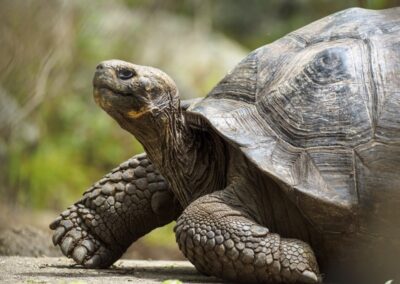At first glance, alligators and crocodiles appear nearly identical—large, scaly reptiles with fearsome jaws and prehistoric features. But while these apex predators share a common ancestry, they are distinct species with key differences in appearance, behavior, and habitat.
Both alligators and crocodiles belong to the order Crocodylia, a group of reptiles that also includes caimans and gharials. Despite their evolutionary similarities, they’ve adapted to different environments and possess unique traits that set them apart—from the shape of their snouts to their levels of aggression.
In this article, we’ll explore the differences between alligators and crocodiles in detail. We’ll break down their physical characteristics, habitats, feeding habits, and aggression levels, while also comparing male vs. female traits and taking a closer look at related species like caimans. To top it off, we’ll settle the ultimate question: who would win in a fight—and which species is more dangerous to humans?
Whether you’re curious about spotting these creatures in the wild or just want a detailed alligator vs crocodile comparison, this guide has you covered.
Main Differences Between Alligators and Crocodiles
Comparison Chart: Alligator vs. Crocodile
| Feature | Alligator | Crocodile |
| Snout Shape | U-shaped, broad | V-shaped, narrow |
| Skin Color | Darker, grayish black | Olive green or brown |
| Habitat | Freshwater | Fresh & saltwater |
| Aggression Level | Less aggressive | More aggressive |
| Teeth Visibility | Upper teeth visible only | Upper & lower teeth visible |
| Geographic Range | US (esp. Florida, Louisiana), China | Africa, Asia, Americas, Australia |
| Salt Glands | Non-functional | Functional (helps in saltwater) |
| Speed (Land/Water) | ~11 mph / ~20 mph | ~9–10 mph / ~15–18 mph |
Now that we’ve laid out the core differences between these formidable reptiles, let’s take a closer look at each species individually—starting with the alligator.
Alligator Facts and Information Overview
Alligators are large, powerful reptiles that have roamed Earth for millions of years. Often confused with crocodiles due to their similar appearance, alligators are a distinct species within the Alligatoridae family and are primarily found in the southeastern United States and parts of China. Known for their U-shaped snouts, stealthy hunting techniques, and territorial behavior, alligators have evolved to thrive in freshwater environments. This section explores their species breakdown, physical characteristics, environmental adaptations, and behavioral tendencies.
To understand what defines an alligator, it helps to begin with its species breakdown and place in the reptile family tree.
Species & Classification
There are two recognized species of alligators: the American alligator (Alligator mississippiensis) and the Chinese alligator (Alligator sinensis). The American alligator is much more common and widely distributed across the southeastern United States, while the Chinese alligator is smaller and critically endangered, surviving only in isolated parts of eastern China. Both species are members of the Alligatoridae family, which also includes caimans. Evolutionarily, alligators diverged from crocodiles over 30 million years ago, developing traits suited to more temperate freshwater habitats.
Physical Characteristics
Male alligators can grow as long as 13 to 15 feet and weigh up to 1,000 pounds, while females are generally smaller, measuring around 9 to 10 feet. One of the most distinctive features of an alligator is its broad, U-shaped snout, which is designed for crushing hard-shelled prey like turtles. Their powerful jaws can exert a bite force of up to 2,000 pounds per square inch (PSI), making them formidable predators. Alligator skin is dark gray to black and covered with rough, bony scales called osteoderms that serve as natural armor. Their hind feet are webbed, allowing for agile swimming, and their sharp claws help them dig and defend themselves on land. The muscular tail plays a key role in propulsion through water and can also be used as a weapon. Despite their bulky appearance, alligators are surprisingly fast on land and can gallop in short bursts, reaching speeds up to 11 miles per hour. Their eyes and nostrils are positioned high on the skull, enabling them to see and breathe while mostly submerged. Alligators also possess specialized pressure receptors that allow them to detect even the slightest movements in the water, and their excellent night vision enhances their ability to hunt in low light.
Habitat & Environment
Alligators are most commonly found in freshwater environments such as swamps, rivers, lakes, and ponds. They thrive in the southeastern United States, particularly in Florida, which alone is home to an estimated 1.3 million alligators, as well as Louisiana, Georgia, and Texas. These reptiles prefer warm, humid climates and rely on external heat sources to regulate their body temperature. Basking in the sun is a common behavior, especially during cooler seasons. The Chinese alligator, in contrast, inhabits a much narrower range and is considered one of the world’s most endangered reptiles due to habitat loss and human activity.
Diet & Behavior
Alligators are opportunistic carnivores that feed on a wide variety of animals, including fish, birds, turtles, snakes, and small to medium-sized mammals. They are known for their ambush-hunting style, remaining almost completely still in the water until the right moment to strike. Their strong jaws and sharp teeth allow them to seize and subdue prey with precision. Alligators are typically crepuscular, meaning they are most active during dawn and dusk, although they may also hunt at night. In some cases, they have been observed storing food underwater in submerged areas to consume later. While primarily carnivorous, some studies suggest that alligators occasionally eat fruit, showing a more varied diet than previously believed.
Aggression & Human Interaction
Compared to crocodiles, alligators are generally less aggressive toward humans. On average, there is approximately one fatal alligator attack per year in the United States, and most encounters do not result in injury. Alligators tend to avoid confrontation and will usually retreat if approached. However, they can become highly aggressive when defending nests or territory, especially during breeding season. Human-alligator interactions are most likely in areas where human development overlaps with natural alligator habitats, such as golf courses, retention ponds, and residential neighborhoods in Florida.
Males vs. Females
Male and female alligators exhibit several behavioral and physical differences. Males tend to be significantly larger and more territorial, especially during mating season. They are known to produce deep, resonant bellows to attract females and warn other males to stay away. Females, while smaller in size, are known for their intense maternal instincts. They construct and guard nests built from vegetation and will aggressively defend their young against any perceived threats, including humans. After hatching, mother alligators often carry their babies to the water in their mouths and continue to protect them for several weeks or even months.
Crocodile Information and Facts Overview
Crocodiles are one of the oldest surviving reptile species on Earth, with fossils dating back over 200 million years. Known for their aggressive nature and global distribution, crocodiles are often mistaken for alligators, yet the differences between them are both subtle and significant. Crocodiles tend to be larger, more aggressive, and more adaptable to saltwater environments. They are members of the Crocodylidae family and inhabit tropical regions across Africa, Asia, the Americas, and Australia. In this section, we’ll explore what makes crocodiles unique—from their physical traits and species variation to their behavioral patterns and interaction with humans.
Now that we’ve covered the alligator in depth, let’s shift focus to its more aggressive, salt-tolerant cousin—the crocodile.
Species & Classification
Crocodiles belong to the family Crocodylidae and include over a dozen recognized species, each with varying sizes, habitats, and behaviors. Among the most well-known species are the Nile crocodile (Crocodylus niloticus), Saltwater crocodile (Crocodylus porosus), American crocodile (Crocodylus acutus), and Mugger crocodile (Crocodylus palustris). The saltwater crocodile is the largest living reptile, with males reaching lengths of up to 23 feet. Crocodiles are more globally distributed than alligators and are found throughout Africa, Southeast Asia, northern Australia, and parts of Central and South America. Unlike alligators, many crocodile species have salt glands on their tongues that allow them to survive in brackish and saltwater environments, giving them a wider range of habitats.
Physical Characteristics
Crocodiles are typically longer, leaner, and lighter in color than alligators. The average male crocodile can reach 14 to 17 feet, though some saltwater crocodiles have been documented exceeding 20 feet and weighing over 2,200 pounds. Their snouts are narrower and V-shaped, which helps distinguish them from the broader U-shaped snouts of alligators. This snout design is better suited for catching fish and swift prey in aquatic environments. Crocodiles have a slightly weaker bite force than alligators, ranging between 3,000 to 3,700 PSI, depending on the species—still powerful enough to crush bones and drag prey underwater. Their skin tends to be lighter in color, ranging from olive green to tan with dark crossbanding on the body and tail. Like alligators, crocodiles are armored with osteoderms, though they often appear more rugged and angular. Their feet are partially webbed, and they possess sharp claws, while their tails serve as primary tools for swimming and defense. Crocodiles also have prominent teeth that remain visible even when their mouths are closed, with the fourth tooth on each side of the lower jaw typically exposed—a key difference from alligators. Their eyes, like those of alligators, provide night vision and are adapted for ambush hunting with elevated positioning and water-level visibility.
Habitat & Environment
Crocodiles are found in a broader range of habitats than alligators and are well-adapted to both freshwater and saltwater environments. They typically live in rivers, lakes, wetlands, estuaries, and coastal regions. The saltwater crocodile, in particular, is famous for its ability to travel across vast ocean distances and has been seen hundreds of miles from land. The Nile crocodile is widespread across sub-Saharan Africa and is known to thrive in both remote marshes and heavily populated areas. The American crocodile is found in southern Florida, the Caribbean, and parts of Central and South America, but is far less common than the American alligator. Crocodiles are cold-blooded like all reptiles, and basking in the sun is essential for maintaining optimal body temperature.
Diet & Behavior
Crocodiles are apex predators and opportunistic hunters that consume a wide range of prey, including fish, amphibians, reptiles, birds, and mammals. Larger crocodiles have been known to attack big animals such as antelope, water buffalo, and even sharks in rare cases. They use ambush tactics, lying in wait near water edges before launching lightning-fast attacks. Unlike alligators, crocodiles often exhibit cooperative hunting behaviors, especially during fish kills or large feeding events, though this varies by species. Crocodiles are less crepuscular than alligators and may be active both day and night. While their diet and methods of hunting are similar in concept, their aggression and feeding dominance often place them higher on the food chain within their ecosystems.
Aggression & Human Interaction
Crocodiles are widely regarded as more aggressive and dangerous to humans than alligators. The Nile crocodile and saltwater crocodile are responsible for the majority of crocodile attacks worldwide. According to the CrocBITE database, Nile crocodiles cause an estimated 200–300 deaths annually in Africa alone, a stark contrast to the average of one fatal alligator attack per year in the U.S. Crocodiles are more likely to view humans as prey, especially in areas where they coexist closely with communities. Their tendency to defend territory aggressively and their willingness to strike without provocation make them a greater threat in the wild. In regions like northern Australia and sub-Saharan Africa, locals are often warned to avoid riverbanks and estuaries where crocodiles are known to hunt.
Males vs. Females
As with alligators, male crocodiles are typically larger and more dominant, especially during the breeding season. Males establish territories and often engage in violent displays or combat with rivals. During mating season, they emit deep growls and display physical gestures such as tail slapping to attract females and deter competitors. Female crocodiles are smaller but exhibit strong maternal instincts. After laying eggs, they guard the nests fiercely for several months and often assist hatchlings in reaching the water. However, their level of parental care varies more widely by species than it does in alligators. For example, saltwater crocodile mothers tend to show less prolonged maternal care compared to American alligator mothers, who remain with their young for longer periods.
With both species examined, it’s time to pit them head-to-head. If an alligator fought a crocodile, who would come out on top?
Who Would Win in a Fight – a Croc or an Alligator?
The question of who would win in a battle between an alligator and a crocodile is a popular one—and while the two reptiles may seem evenly matched at a glance, the outcome is overwhelmingly one-sided when you dig into the facts. Although both are powerful predators, the saltwater crocodile’s massive size, sheer bite force, and aggressive temperament give it the edge in nearly every physical confrontation.
Alligator vs. Crocodile: Fight Stats
In a head-to-head encounter, the saltwater crocodile would almost always defeat the American alligator, primarily due to several overwhelming advantages. First and foremost is the size difference. While adult male alligators top out around 13 to 15 feet, saltwater crocodiles can exceed 20 feet in length and weigh over 2,200 pounds. This alone makes them dominant in most territorial disputes.
Bite force is another critical factor. A crocodile’s bite can reach up to 3,700 pounds per square inch (psi)—almost double that of an alligator’s 2,000 psi. This kind of crushing power enables crocodiles to subdue much larger prey and fend off rivals more effectively. Furthermore, crocodiles are known to be far more aggressive and territorial, and their instincts push them to initiate combat rather than avoid it. In contrast, alligators are more defensive and tend to retreat unless provoked.
Another consideration is the environment. Crocodiles are highly adaptable and tolerate saltwater much better than alligators, allowing them to dominate in a wider range of coastal territories and estuaries, which gives them a strategic advantage in encounters that occur near brackish or marine environments.
To put the key fight stats in perspective, here’s how the two species compare:
| Animal | Average Attack Fatalities (per year) | Bite Force | Known Aggression |
| Alligator | Fewer than 10 (primarily in the U.S.) | ~2,000 psi | Moderate |
| Crocodile | Over 300 globally | ~3,700 psi | High |
In conclusion, while an American alligator is certainly a powerful and capable predator, it would be significantly outmatched in most confrontations with a crocodile—especially when facing larger species like the saltwater or Nile crocodile. Their physical superiority, heightened aggression, and environmental flexibility make crocodiles the likely victor in nearly every scenario.
Of course, alligators and crocodiles aren’t the only members of the Crocodylia family. Let’s not forget about their smaller but scrappier cousin: the caiman.
What About Caimans?
Caimans are smaller cousins of alligators that live primarily in the freshwater rivers and wetlands of Central and South America. Like alligators, they are members of the Alligatoridae family, but they differ in size, behavior, and snout shape. While they don’t often enter the spotlight of “who would win” debates, caimans are worth mentioning due to their distinct place in the crocodilian family tree.
Caimans generally grow to between 6 and 8 feet in length, with some species, like the black caiman, reaching up to 13 feet—comparable to a mid-sized alligator. However, most caimans are smaller, more agile, and notably more aggressive than alligators relative to their size. Their narrower snouts are adapted for catching fish and other aquatic prey, and they rely more on speed and stealth than raw power.
There are several notable species within the caiman group, including the spectacled caiman, which is the most widespread, the yacare caiman, found in South America’s Pantanal, and the black caiman, the largest of the group and one of the few caiman species that poses a threat to humans.
While caimans are unlikely to win in a fight against a crocodile—or even a large alligator—their aggressive disposition, adaptability, and stealthy behavior make them formidable predators within their own ecosystems.
Geographic Highlights: Florida & Beyond
When comparing alligators and crocodiles, geography plays a critical role in shaping their behaviors, interactions, and even the likelihood of encountering one in the wild. Although they belong to the same order, these two reptiles are typically separated by continents and ecosystems—except in one extraordinary place. Understanding where these creatures thrive helps underscore their differences in habitat preference, climate adaptability, and evolutionary history.
Florida: A Rare Overlap
Florida is the only region in the world where alligators and crocodiles coexist naturally in the wild, creating a unique opportunity for comparison and conservation. This rare overlap primarily occurs in Everglades National Park, a massive wetland preserve in southern Florida, renowned for its diverse wildlife. American alligators are abundant throughout the state and are commonly found in freshwater marshes, rivers, and lakes inland. In contrast, American crocodiles are much rarer and tend to inhabit coastal and brackish environments, such as estuaries, mangrove swamps, and tidal creeks.
While encounters with alligators are relatively common in Florida suburbs and golf courses, crocodile sightings are mostly limited to southernmost areas near Florida Bay and the Keys. This geographic proximity, yet clear habitat distinction, highlights how even closely related species can adapt to different ecological niches within the same region.
Other Key Regions
Beyond Florida, alligators and crocodiles are distributed across various continents, each finding dominance in their respective ecosystem. Louisiana holds the distinction of having the highest population of alligators in the United States, with over 2 million wild individuals—surpassing even Florida. These alligators thrive in Louisiana’s swamps, bayous, and wetlands, which provide ideal freshwater conditions and an abundance of prey.
On the other side of the world, Australia is home to the world’s largest crocodile species—the saltwater crocodile. Found throughout northern Australia, particularly in the Northern Territory and Queensland, these crocodiles are known for their aggressive behavior and capacity to travel through both saltwater and freshwater systems.
In Africa, the Nile crocodile reigns supreme as one of the most feared predators on the continent. Common in rivers and lakes across sub-Saharan Africa, the Nile crocodile is responsible for hundreds of human fatalities each year, often in communities that live close to water sources.
Meanwhile, China is home to the Chinese alligator, a critically endangered species with only a few hundred individuals remaining in the wild. Restricted to the lower Yangtze River, the Chinese alligator is much smaller and more reclusive than its American cousin and faces severe threats from habitat destruction and human development.
We’ve covered the facts and explored the ecosystems. Now, let’s recap the major takeaways—and settle the debate on which crocodilian reigns supreme.
Crocodile vs Alligators, which is More Dangerous — and Which Is Cooler?
When comparing alligators, crocodiles, and even caimans, several defining traits help determine which is more dangerous—and which might be considered more fascinating. Crocodiles come out on top in terms of aggression, size, and bite force. Their global presence and higher fatality rates make them one of the most lethal animals humans might encounter in the wild. With a bite force nearing 3,700 psi and a documented record of over 300 attacks per year globally, crocodiles are truly apex predators.
Alligators, on the other hand, are generally less aggressive and more likely to avoid conflict with humans. While still fearsome and incredibly strong, especially in defense of their nests, alligators cause significantly fewer fatal attacks and often inhabit areas closer to human development in the southeastern U.S. They are also more commonly seen and appreciated in wildlife parks and educational settings.
Caimans fall somewhere in between. Though smaller, they are known to be surprisingly aggressive for their size and can be difficult to manage in captivity or conservation settings. The black caiman, in particular, can grow quite large and is not to be underestimated.
Ultimately, when it comes to which species is “cooler,” the answer is subjective. Some may be drawn to the raw power and ancient mystique of crocodiles, while others appreciate the adaptability and maternal behavior of alligators. But one thing is certain: whether it’s a crocodile in the Nile, an alligator in the Everglades, or a caiman in the Amazon, these reptiles are best admired from a distance—better seen than tested.
From their evolutionary paths to their habitats and behaviors, alligators, crocodiles, and caimans each bring something unique to the world of reptiles. Whether you’re drawn to the raw power of a saltwater crocodile or the stealthy presence of an American alligator, one thing is clear—these ancient predators deserve both our respect and our caution. The next time you’re near a swamp or riverbank, remember: it’s their territory, and you’re just passing through.




